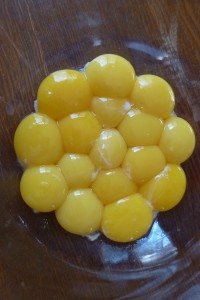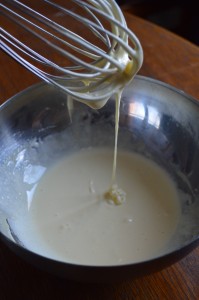 Custard is broadly defined as a cooked mixture of liquid and egg. The liquid dilutes the egg protein, so when the mixture is cooked and the protein coagulates it forms a very delicate network that gives the custard structure. In western cooking the liquid is almost always milk and cream, though stock can also be used. In classical French cooking a royale is a custard made from stock and egg that is cut into geometric shapes and floated in consommé.
Custard is broadly defined as a cooked mixture of liquid and egg. The liquid dilutes the egg protein, so when the mixture is cooked and the protein coagulates it forms a very delicate network that gives the custard structure. In western cooking the liquid is almost always milk and cream, though stock can also be used. In classical French cooking a royale is a custard made from stock and egg that is cut into geometric shapes and floated in consommé.
Most custards are comprised of roughly 4 parts dairy and 1 part egg. The inclusion of egg whites makes for glossier, firmer custards, while using only yolks creates softer, creamier versions.
What’s remarkable about custard is the variety of consistencies the cook can create with the same ingredients in the same proportions simply by using different cooking techniques. Over the next few days on Button Soup we will make a handful of classic custards that all use a 4:1:1 ratio: 4 parts milk and cream, 1 part egg yolk, and 1 part sugar. With this single ratio we will make custards with consistencies that vary from sauce, to pudding, to crème brûlée, and finally to ice cream.
For now let’s discuss some basic custard theory.
Set custards versus stirred custards. The simplest way to affect the texture of a custard is by stirring it while it cooks. If we pour a custard mix into a ramekin and cook it without stirring it will form a delicate but staid custard that you could turn upside down without incident, like they do at Dairy Queen. If we took the exact same ingredients and gently cooked them in a pot on the stove while stirring, we would end up with a viscous but pourable liquid. Cooks often make the distinction between set custards and stirred custards. Stirred custards are sometimes called creams.
Whether you are making a set custard or a stirred custard, the process for preparing the mixture is the same. Usually the first step is to scald the milk and cream. This is actually an old procedure from the days when milk quality was less certain than it is now. Modern pastry cooks still scald their dairy so that they can infuse the cream with flavours like vanilla. Scalding the dairy will also reduce the cooking time of the final custard, as the ingredients will already be warm.

While the dairy is coming to a boil, classical recipes have the cook ribbon the sugar and egg yolk. This just means whisk the two ingredients together until the yolks turn pale and the mixture falls away from the raised whisk in a long ribbon. It was formerly thought that this process helped produce a smoother custard. In reality ribboning does not affect the final texture of the dish, but is simply an indication that all the sugar has dissolved into the yolk.
Once the dairy has boiled, it is used to temper the egg mixture. Tempering is just a fancy way of saying slowly add the hot dairy to the cold egg. If you were to add the cold egg mixture to the dairy it would curdle as soon as a small piece of egg hit the hot liquid. Slowly adding the hot dairy to the egg mixture quickly but gently heats the eggs to just below their coagulation temperature.
Now we must cook our custard so that the proteins set and give the dish structure. Custards set somewhere between 79-83°C, and overshooting this range will result in a grainy, curdled mess. The slower we cook the mixture, the longer the custard will stay in this ideal temperature range, giving us more time to recognize the doneness and remove the custard. To cook custards gently cooks usually use double boilers or water baths. These techniques and all the other nuances of cooking custards will be discussed in the next few posts.